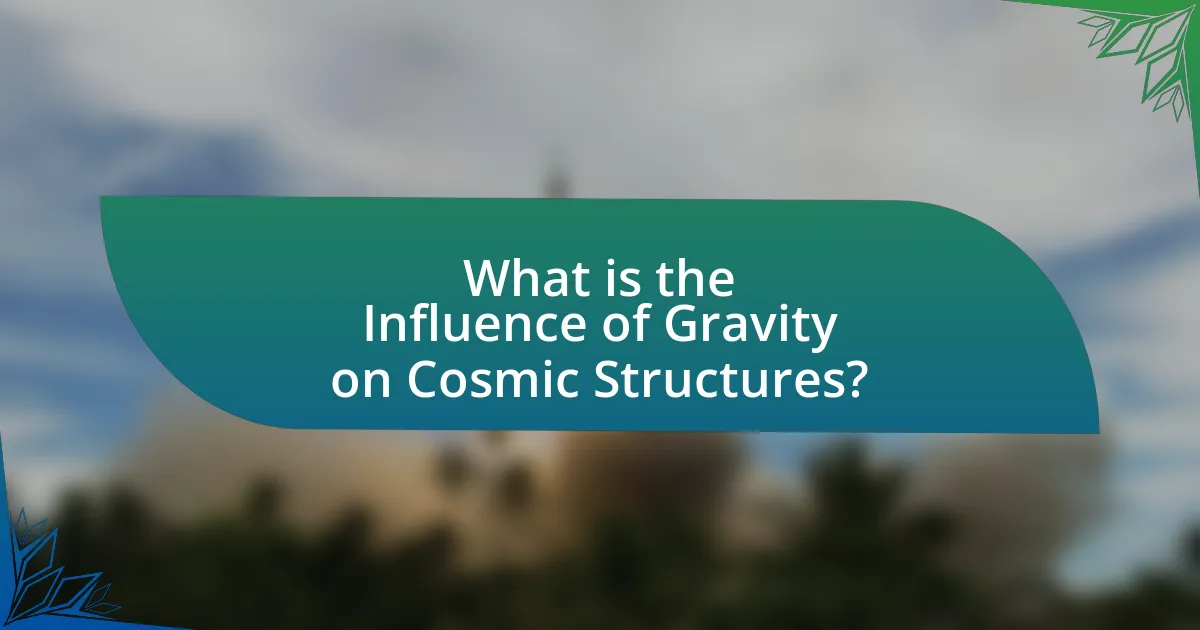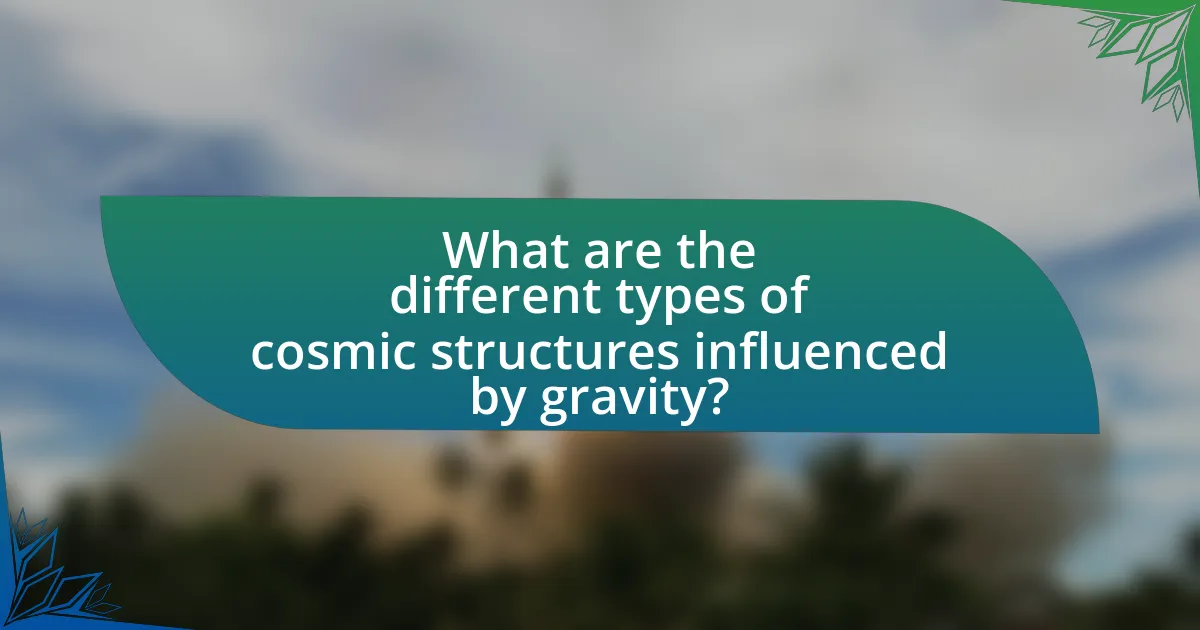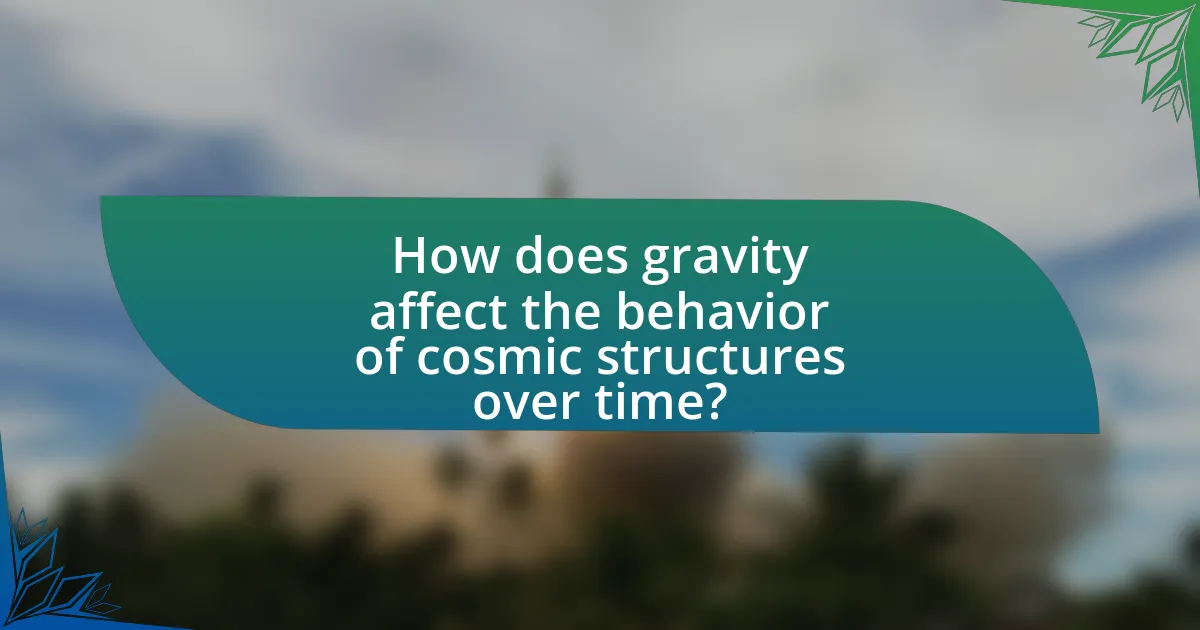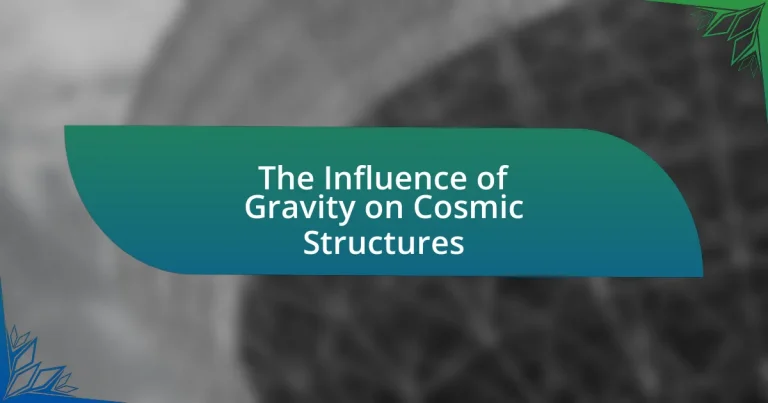Gravity is the fundamental force that shapes cosmic structures, influencing the formation, evolution, and dynamics of celestial bodies. This article explores how gravity governs the aggregation of matter into galaxies, galaxy clusters, and the cosmic web, while also examining its interactions with other fundamental forces. Key topics include the role of gravity in star formation, the characteristics of galaxies, the significance of dark matter, and the dynamics within superclusters. Additionally, the article discusses the long-term effects of gravity on cosmic evolution and its practical implications for predicting cosmic events and observing gravitational effects in space.

What is the Influence of Gravity on Cosmic Structures?
Gravity is the fundamental force that shapes cosmic structures by influencing the formation, evolution, and dynamics of celestial bodies. It governs the attraction between masses, leading to the aggregation of matter into larger structures such as galaxies, galaxy clusters, and the cosmic web. For instance, observations show that gravity causes gas and dust in space to collapse and form stars, while the gravitational pull of galaxies can affect the motion of nearby galaxies, leading to interactions and mergers. Additionally, gravitational lensing, a phenomenon where massive objects bend light from distant sources, provides evidence of gravity’s role in the distribution of mass in the universe. These interactions and formations are supported by the framework of general relativity, which describes gravity as the curvature of spacetime caused by mass.
How does gravity shape the formation of cosmic structures?
Gravity is the fundamental force that governs the formation of cosmic structures by attracting matter together, leading to the creation of galaxies, stars, and larger cosmic formations. As matter in the universe begins to clump due to gravitational attraction, regions of higher density attract more matter, resulting in the hierarchical structure formation observed in the universe today. This process is supported by the theory of cosmic inflation and the observations of the cosmic microwave background radiation, which indicate that small fluctuations in density led to the large-scale structure we see. Additionally, simulations of cosmic evolution, such as those conducted by the Millennium Simulation project, demonstrate how gravity drives the clustering of dark matter and baryonic matter, ultimately shaping the universe’s architecture.
What are the fundamental forces at play in cosmic structure formation?
The fundamental forces at play in cosmic structure formation are gravity, electromagnetism, and the strong and weak nuclear forces. Gravity is the dominant force that governs the large-scale structure of the universe, influencing the formation of galaxies, galaxy clusters, and the overall cosmic web. Electromagnetism plays a role in the interactions of charged particles, affecting the behavior of matter in stars and galaxies. The strong nuclear force binds protons and neutrons in atomic nuclei, while the weak nuclear force is responsible for certain types of particle decay. These forces collectively shape the evolution of cosmic structures, with gravity being the primary driver of large-scale dynamics, as evidenced by observations of galaxy formation and cosmic microwave background radiation.
How does gravity interact with other forces in the universe?
Gravity interacts with other forces in the universe by influencing the behavior of matter and energy, particularly through its role in the formation and dynamics of cosmic structures. For instance, gravity is the dominant force in large-scale structures like galaxies and galaxy clusters, where it governs the motion of stars and gas, counteracting the effects of electromagnetic forces that govern atomic interactions. Additionally, gravity plays a crucial role in the context of general relativity, where it is intertwined with spacetime and affects the propagation of light, demonstrating its interaction with electromagnetic forces. This interaction is evidenced by phenomena such as gravitational lensing, where massive objects bend light from distant sources, illustrating how gravity can influence electromagnetic radiation.
Why is gravity considered a key factor in the universe’s evolution?
Gravity is considered a key factor in the universe’s evolution because it governs the formation and dynamics of cosmic structures. The gravitational force causes matter to clump together, leading to the formation of stars, galaxies, and larger structures like galaxy clusters. This process is supported by the observation that after the Big Bang, gravity played a crucial role in the cooling and coalescing of matter, allowing for the creation of the first stars and galaxies approximately 400 million years later. Additionally, gravitational interactions dictate the motion of celestial bodies, influencing the overall structure and expansion of the universe, as evidenced by the discovery of dark energy, which is linked to the gravitational dynamics of the cosmos.
What role does gravity play in the lifecycle of stars?
Gravity is the fundamental force that governs the lifecycle of stars by initiating their formation, regulating their evolution, and ultimately determining their fate. During star formation, gravity causes gas and dust in molecular clouds to collapse into dense regions, leading to the birth of protostars. As the protostar continues to accumulate mass, gravitational pressure increases, eventually igniting nuclear fusion in its core, which marks the transition to the main sequence phase of a star’s life.
Throughout a star’s lifecycle, gravity maintains equilibrium between the outward pressure from nuclear fusion and the inward pull of gravity. This balance allows stars to remain stable for billions of years. When a star exhausts its nuclear fuel, gravity plays a crucial role in its subsequent evolution; it causes the core to collapse, leading to various outcomes depending on the star’s mass. For example, low-mass stars become red giants and shed their outer layers, forming planetary nebulae, while high-mass stars may undergo supernova explosions, leaving behind neutron stars or black holes.
The influence of gravity is evident in the processes of stellar nucleosynthesis, where elements are formed during a star’s life cycle, and in the gravitational interactions that lead to the formation of star clusters and galaxies. Thus, gravity is essential in shaping the lifecycle of stars and the structure of the universe.
How does gravity influence the formation of galaxies?
Gravity is the primary force that influences the formation of galaxies by attracting matter together. As gas and dust in the universe begin to clump due to gravitational attraction, they form denser regions that eventually collapse under their own gravity, leading to the creation of stars and galaxies. This process is supported by observations of cosmic microwave background radiation, which indicates the density fluctuations in the early universe that gravity acted upon, facilitating the formation of large-scale structures like galaxies. Additionally, simulations of galaxy formation demonstrate that gravity plays a crucial role in the hierarchical merging of smaller structures into larger galaxies over time.

What are the different types of cosmic structures influenced by gravity?
The different types of cosmic structures influenced by gravity include galaxies, galaxy clusters, superclusters, and cosmic filaments. Galaxies are massive systems composed of stars, gas, dust, and dark matter, held together by gravitational forces. Galaxy clusters are groups of galaxies that are bound together by gravity, often containing hundreds to thousands of galaxies. Superclusters are large groups of galaxy clusters, representing some of the largest known structures in the universe, while cosmic filaments are vast, thread-like formations of galaxies and dark matter that form the backbone of the cosmic web. These structures are shaped and maintained by gravitational interactions, which dictate their formation and evolution over cosmic time.
What are the characteristics of galaxies shaped by gravitational forces?
Galaxies shaped by gravitational forces exhibit distinct characteristics such as their structure, dynamics, and distribution of matter. These galaxies often display a spiral, elliptical, or irregular morphology, influenced by the gravitational interactions among stars, gas, and dark matter. For instance, spiral galaxies, like the Milky Way, have well-defined arms that emerge from a central bulge, a result of gravitational forces organizing stars and gas into a rotating disk. Elliptical galaxies, on the other hand, are more spherical and lack the distinct structure of spirals, indicating a different gravitational history, often resulting from mergers of smaller galaxies. Additionally, gravitational forces dictate the motion of stars within galaxies, leading to specific velocity distributions that can be observed and measured, such as the flat rotation curves seen in spiral galaxies, which suggest the presence of dark matter. These characteristics are supported by observational data from telescopes and simulations that illustrate how gravity shapes the formation and evolution of galaxies over cosmic time.
How do different types of galaxies respond to gravitational influences?
Different types of galaxies respond to gravitational influences in distinct ways based on their structure and composition. Spiral galaxies, for instance, exhibit a well-defined rotation curve influenced by the gravitational pull of their central supermassive black holes and surrounding dark matter, leading to stable, rotating disks. Elliptical galaxies, on the other hand, have more random stellar motions and are less affected by gravitational interactions, resulting in a more isotropic distribution of stars. Irregular galaxies respond to gravitational influences by undergoing significant tidal interactions, often leading to star formation triggered by gravitational perturbations from nearby galaxies. These behaviors are supported by observations such as the rotation curves of spiral galaxies indicating dark matter presence and the interactions observed in galaxy clusters, which demonstrate how gravitational forces shape galaxy morphology and dynamics.
What is the significance of dark matter in galaxy formation?
Dark matter is crucial in galaxy formation as it provides the necessary gravitational framework for galaxies to form and evolve. Its presence influences the distribution of visible matter, leading to the formation of structures in the universe. Observations, such as the rotation curves of galaxies, indicate that the mass of galaxies is significantly greater than what is visible, suggesting that dark matter constitutes about 27% of the universe’s total mass-energy content. This unseen mass affects the gravitational pull, allowing galaxies to coalesce and maintain their structure despite the high velocities of their stars.
How do clusters and superclusters form under the influence of gravity?
Clusters and superclusters form under the influence of gravity through the gravitational attraction of matter in the universe. Initially, small density fluctuations in the early universe led to regions where matter began to accumulate. As these regions attracted more matter due to gravitational forces, they grew denser and eventually formed galaxy clusters. Over time, these clusters continued to merge and attract surrounding matter, leading to the formation of larger structures known as superclusters. This process is supported by observations of the cosmic microwave background radiation, which indicates the presence of density fluctuations that seeded the formation of these large-scale structures.
What processes lead to the formation of galaxy clusters?
Galaxy clusters form primarily through the gravitational attraction of matter in the universe, leading to the merging of smaller structures such as galaxies and groups of galaxies. This process begins with the initial density fluctuations in the early universe, which are amplified by gravity, causing regions of higher density to attract surrounding matter. Over time, these regions grow through a series of mergers and accretion events, where smaller clusters combine to form larger ones.
Evidence supporting this process includes observations of the cosmic microwave background radiation, which indicates the density fluctuations present shortly after the Big Bang, and simulations of large-scale structure formation that show how gravity drives the clustering of matter. Additionally, studies of galaxy cluster distributions and their dynamics provide insights into the gravitational interactions that facilitate cluster formation.
How does gravity affect the dynamics within superclusters?
Gravity significantly influences the dynamics within superclusters by governing the motion and interaction of galaxies and dark matter. The immense gravitational pull of superclusters causes galaxies to cluster together, leading to the formation of large-scale structures in the universe. This gravitational attraction results in the movement of galaxies toward denser regions, creating a hierarchical structure where smaller groups merge into larger ones. Observations, such as the motion of galaxies in the Virgo Supercluster, demonstrate that gravity not only binds galaxies together but also dictates their velocities and trajectories, confirming that gravitational forces are fundamental in shaping the overall dynamics of superclusters.

How does gravity affect the behavior of cosmic structures over time?
Gravity significantly influences the behavior of cosmic structures over time by governing their formation, evolution, and interactions. As a fundamental force, gravity causes matter to clump together, leading to the formation of galaxies, stars, and planetary systems. For instance, the gravitational attraction between particles in a molecular cloud initiates star formation, while the gravitational pull of galaxies can lead to mergers and interactions that reshape their structures.
Over billions of years, gravity also drives the expansion of the universe, influencing the large-scale structure by causing galaxies to cluster and form filaments and voids. Observations from the Cosmic Microwave Background radiation and galaxy surveys support this, showing how gravitational forces have shaped the distribution of matter in the universe. Thus, gravity is a key factor in the dynamic behavior and evolution of cosmic structures throughout cosmic history.
What are the long-term effects of gravity on cosmic evolution?
The long-term effects of gravity on cosmic evolution include the formation and clustering of galaxies, the development of large-scale structures, and the eventual fate of the universe. Gravity acts as the primary force that governs the dynamics of matter in the universe, leading to the coalescence of gas and dust into stars and galaxies. Over billions of years, gravitational interactions cause galaxies to merge and form larger structures, contributing to the observed cosmic web of filaments and voids.
Additionally, gravity influences the expansion of the universe; it counteracts the effects of dark energy, which drives accelerated expansion. The interplay between gravity and dark energy will ultimately determine the universe’s fate, whether it leads to continued expansion, a stable state, or a potential collapse. Observational evidence, such as the distribution of galaxies and cosmic microwave background radiation, supports these conclusions, demonstrating how gravity shapes the large-scale structure of the cosmos over time.
How does gravitational attraction lead to the merging of galaxies?
Gravitational attraction causes galaxies to merge by pulling them together through their mutual gravitational forces. As galaxies approach each other, their gravitational fields interact, leading to tidal forces that distort their shapes and accelerate their movement towards one another. This process can result in the eventual coalescence of the galaxies into a single, larger galaxy. Observational evidence, such as the merging of the Milky Way and Andromeda galaxies, supports this phenomenon, demonstrating that gravitational attraction is a fundamental mechanism in the evolution of cosmic structures.
What is the impact of gravity on the expansion of the universe?
Gravity significantly influences the expansion of the universe by acting as a counterforce to the expansion driven by dark energy. While the universe is currently expanding, gravity works to slow this expansion by pulling matter together, which can lead to the formation of structures like galaxies and galaxy clusters. Observations, such as those from the Cosmic Microwave Background radiation and the distribution of galaxies, indicate that gravity played a crucial role in shaping the large-scale structure of the universe. Additionally, the balance between gravitational attraction and the repulsive effect of dark energy determines the rate of expansion, as evidenced by the discovery of the universe’s accelerated expansion in the late 1990s through supernova observations.
What practical implications does the study of gravity and cosmic structures have?
The study of gravity and cosmic structures has significant practical implications for understanding the universe’s formation and evolution. This knowledge aids in the development of technologies such as satellite navigation systems, which rely on precise gravitational models to function accurately. Additionally, insights into gravitational interactions inform astrophysics and cosmology, enhancing our comprehension of phenomena like black holes and galaxy formation. For instance, the discovery of gravitational waves has opened new avenues for astronomical observation, allowing scientists to detect and analyze cosmic events that were previously unobservable. These advancements not only deepen our scientific knowledge but also have potential applications in fields like telecommunications and materials science, where gravitational principles can influence design and functionality.
How can understanding gravity help in predicting cosmic events?
Understanding gravity is essential for predicting cosmic events because it governs the motion and interaction of celestial bodies. By applying Newton’s law of universal gravitation and Einstein’s theory of general relativity, scientists can model the gravitational forces acting on objects like stars, planets, and galaxies. For instance, the gravitational pull of a massive object can influence the trajectory of nearby celestial bodies, allowing astronomers to predict phenomena such as asteroid paths or the orbits of exoplanets. Additionally, gravitational waves, which are ripples in spacetime caused by massive accelerating objects, can provide insights into events like black hole mergers. The detection of these waves, first observed by LIGO in 2015, has opened new avenues for understanding cosmic events and their implications for the universe.
What are the best practices for observing gravitational effects in space?
The best practices for observing gravitational effects in space include utilizing precise instruments, conducting long-duration observations, and employing multiple observational methods. Precise instruments, such as gravitational wave detectors like LIGO and Virgo, allow for the measurement of minute changes in spacetime caused by gravitational waves, confirming predictions of general relativity. Long-duration observations, as seen in projects like the Hubble Space Telescope’s deep field surveys, enable astronomers to detect the gravitational influence of distant galaxies on light from more distant objects, revealing the effects of dark matter. Employing multiple methods, such as combining optical, radio, and gravitational lensing observations, enhances the understanding of gravitational effects by providing complementary data that can validate findings across different wavelengths. These practices are essential for accurately studying the influence of gravity on cosmic structures.




